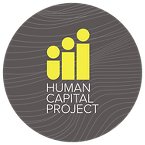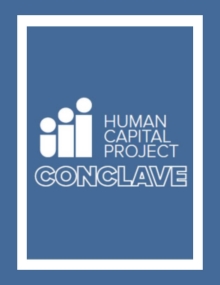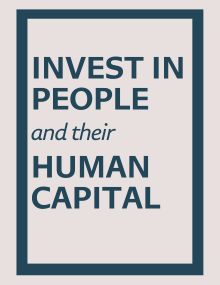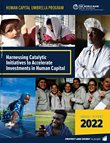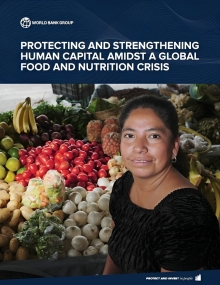Featured
About the HCP
The HCP aims to protect and invest in people. We host the following related webpages: About, Case Studies, Country Knowledge Exchanges, Key Reports, and Frequently Asked Questions. As of April 2024, the HCP has grown to a network of 95 committed governments participating and taking action in three distinct areas. Learn more by clicking on the topics below.
Click to view HCP Network FactsheetThe HCI provides a new definition of human capital and quantifies the contribution of health and education to the productivity of the next generation of workers. Countries can use it to assess how much income they are foregoing because of Human Capital gaps and how much faster they can turn these losses into gains if they act now.
Learn more about the Index and the definition of Human Capital HCI Frequently Asked QuestionsCredible measurement of education and health outcomes is critical locally, nationally, and globally. Within countries, measurement leads to insights into what works and where to target resources. It also increases policymakers’ awareness of the importance of investing in human capital, creating momentum for action. Globally, comprehensive measurement sheds light on the differences between countries and spurs demand for investments in human capital.
Case StudiesThe HCP will help countries tackle the worst barriers to peoples’ development, using a “whole of government” approach. As of April 2024, the HCP has grown to a network of 94 committed governments that have expressed interest in investing in human capital at the highest levels. In addition, a number of “Human Capital Champions”—world leaders, thought leaders, celebrities, and others—have signed on to advocate for the next generation.
Access the human capital "Knowledge Exchange" seriesCore Resources
Recent Reports
The 2020 HCI: Visualization
2020 HCI: Country Briefs and Data
Download the Country Briefs (updated October 2022) that put Human Capital Index (HCI) country data in perspective with Human Capital Complementary Indicators (HCCIs) and specialized Excel files that include detailed data, sources, and methods. These files are available for 172 countries with sufficient data to calculate an HCI value in September 2020. You can download the full HCI 2020 report here. Answers to some frequently asked questions about the HCI can be found here.
Looking for more data? Visit the WBG Databank to see the online HCI database, the HCI World Development Indicator interface, or to find additional metadata. The HCI 2020 also references the socioeconomically-disaggregated Human Capital Index (SES-HCI).
Afghanistan |
Albania |
Algeria |
Angola |
Antigua and Barbuda |
Argentina |
Armenia |
Australia |
Austria |
Azerbaijan |
Bahrain |
Bangladesh |
Belarus |
Belgium |
Benin |
Bhutan |
Bosnia and Herzegovina |
Botswana |
Brazil |
Brunei Darussalam |
Bulgaria |
Burkina Faso |
Burundi |
Cambodia |
Cameroon |
Canada |
Central African Republic |
Chad |
Chile |
China 1 |
Colombia |
Comoros |
Congo, Dem. Rep. |
Congo, Rep. |
Costa Rica |
Côte d'Ivoire |
Croatia |
Cyprus |
Czech Republic |
Denmark |
Dominica |
Dominican Republic |
Ecuador |
Egypt, Arab Rep. |
El Salvador |
Estonia |
Ethiopia |
Fiji |
Finland |
|
France |
Gabon |
Gambia, The |
Georgia |
Germany |
Ghana |
Greece |
Grenada |
Guatemala |
Guinea |
Guyana |
Haiti |
Honduras |
Hungary |
Iceland |
India 1 |
Indonesia |
Iran, Islamic Rep. |
Iraq |
Ireland |
Israel |
Italy |
Jamaica |
Japan |
Jordan |
Kazakhstan |
Kenya |
Kiribati |
Korea, Rep. |
Kosovo |
Kuwait |
Kyrgyz Republic |
Lao PDR |
Latvia |
Lebanon |
Lesotho |
Liberia |
Lithuania |
Luxembourg |
Madagascar |
Malawi |
Malaysia |
Mali |
Malta |
Marshall Islands |
Mauritania |
Mauritius |
Mexico |
Micronesia, Fed. Sts. |
Moldova |
Mongolia |
Montenegro |
Morocco |
Mozambique |
Myanmar |
Namibia |
Nauru |
Nepal |
Netherlands |
New Zealand |
Niger |
Nigeria |
North Macedonia |
Nicaragua |
Norway |
Oman |
Pakistan |
Palau |
Panama |
Papua New Guinea |
Paraguay |
Peru |
Philippines |
Poland |
Portugal |
Qatar |
Romania |
Russian Federation |
Rwanda |
Samoa |
Saudi Arabia |
Senegal |
Serbia |
Seychelles |
Sierra Leone |
Singapore |
Slovak Republic |
Slovenia |
Solomon Islands |
South Africa |
South Sudan |
Spain |
Sri Lanka |
St. Kitts and Nevis |
St. Lucia |
Sudan |
Sweden |
Switzerland |
Tajikistan |
|
Tanzania |
Thailand |
Timor-Leste |
Togo |
Tonga |
Trinidad and Tobago |
Tunisia |
Turkey |
Tuvalu |
Uganda |
Ukraine |
United Arab Emirates |
United Kingdom |
United States |
Uruguay |
Uzbekistan |
Vanuatu |
Vietnam |
West Bank and Gaza |
Yemen, Rep. |
Zambia |
Zimbabwe |
Hong Kong |
Macao |
|
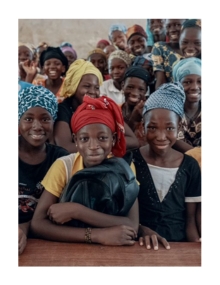
About the program:
Aligned with the World Bank’s Human Capital Project, the Human Capital Umbrella Program helps countries design and implement evidence-based multisectoral initiatives that build, protect, and use human capital across the life cycle through a ‘whole-of-government’ approach. The initiative is supported by the Bill and Melinda Gates Foundation and the Canadian Government and it informs government policies and World Bank-financed operations through data and measurement, technical assistance, and analytical work.
Read more here.
Human Capital Video Playlist
News and Blogs
News
Blogs
Experts

Vice President, People Vice Presidency

Manager, Human Capital Project

